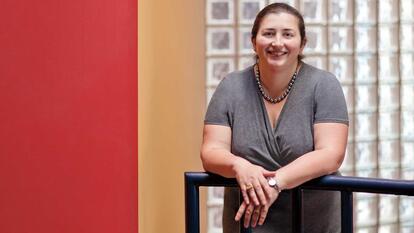Wellesley Joins National Conversation about Public Education with Annual Diane Silvers Ravitch Class of ’60 Lecture

Just days ago a state ballot initiative—to lift the charter school cap—had the Commonwealth thinking about the future of the public schools. To help those who want to better understand the complicated issues that surround public education policy, Wellesley offers one-of-a-kind resources and experts. Most recently, Wellesley hosted Pasi Sahlberg, noted Finnish academic, author, and education reformer, to speak on the intricacies of U.S. education reform for this year’s Diane Silvers Ravitch Class of ’60 Lecture. This was the second year of the lecture series, which author and thought leader Diane Ravitch endowed “to bring some of the best thinkers in education to Wellesley, to showcase the importance of protecting and promoting our public schools,” said Barbara Beatty, professor and chair of education at Wellesley.
“Highlighting teaching as a profession…which is the number-one occupation of Wellesley alumnae over the course of their lives, is fitting on our campus,” said Beatty about the lecture series. “As this year’s speaker Pasi Sahlberg argues, teacher professionalism, collective autonomy, and trust are central to the role of public schools in a democracy.”
In his lecture, Sahlberg, author of Finnish Lessons 2.0, explained that the Finnish education system is founded on the principle that every student learns differently, and therefore schools should accommodate for different talents and kinds of intelligences in children. Sahlberg said these theories originated with American academics, but noted that “those American ideas…that have made other education systems great are not used here in the States, in the school systems.”
He went on to explain that though the United States spends somewhat more per student than Finland, for instance, and is in about the middle of the Organisation for Economic Co-operation and Development’s (OECD) 2016 country statistics on per-pupil spending, many high-performing countries, again such as Finland, spend a greater percentage of their GDP on education than the United States does, which is below the OECD average.
So why doesn’t the United States implement reforms that, Sahlberg argued, work in many other countries? First, he said, U.S. education policy is based more on the state and local level than the national level. Second, too little money is spent on education, and the money goes to the wrong places, like funding already high-performing schools, according to Sahlberg’s research. Finally, he argued that the gap between the rich and the poor in the United States is increasing, and studies show that in general the higher the income inequality of a country, the lower the student performance.
Sahlberg also said that one of the keys to strengthening the U.S. education system is to get more women involved in politics.
–Christine Roberts ’19



